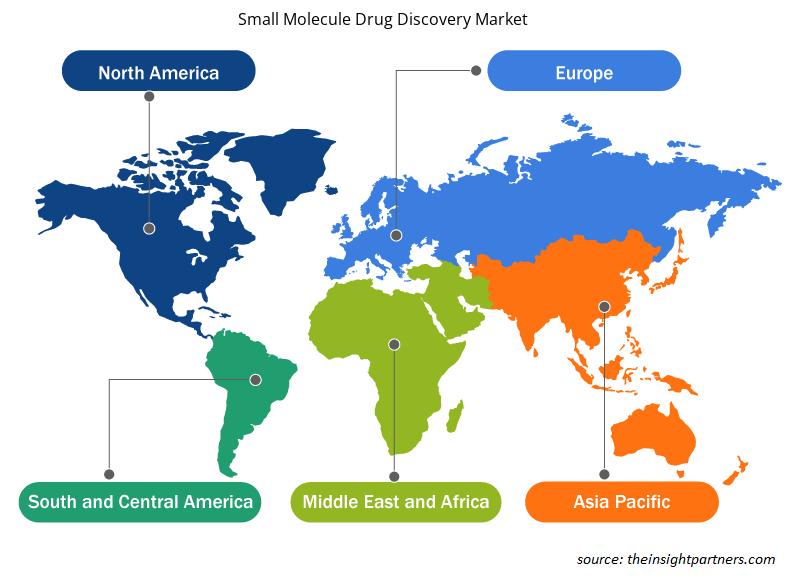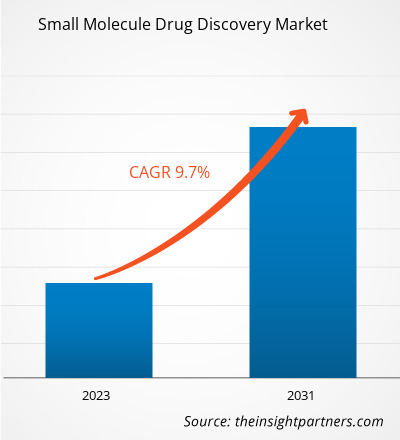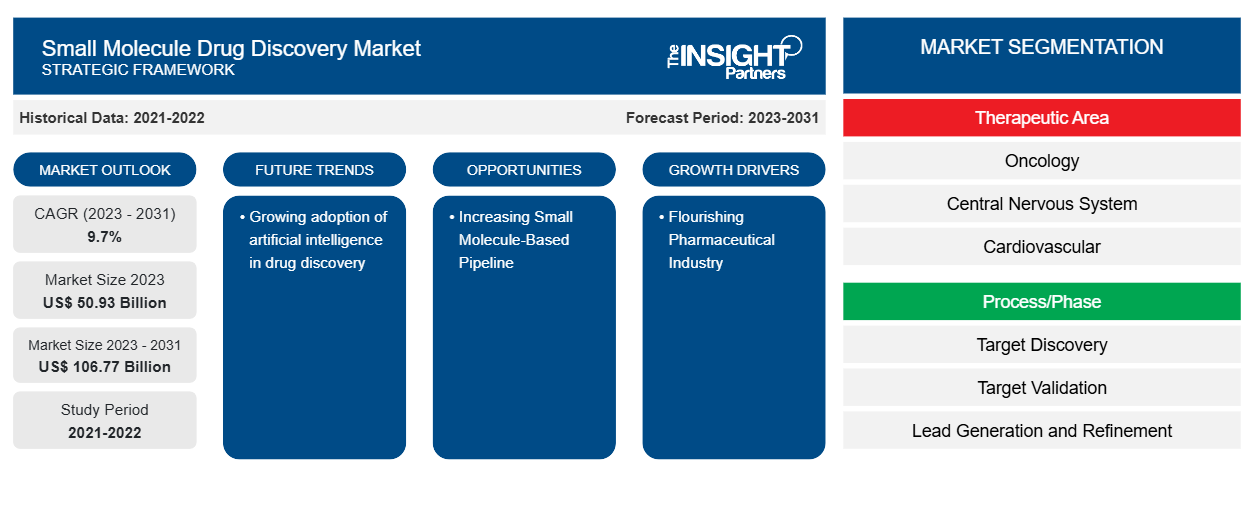Se prevé que el tamaño del mercado de descubrimiento de fármacos de moléculas pequeñas alcance los 106.770 millones de dólares en 2031, frente a los 50.930 millones de dólares en 2023. Se espera que el mercado registre una CAGR del 9,7 % durante el período 2023-2031. Es probable que la creciente adopción de la inteligencia artificial en el descubrimiento de fármacos actúe como una tendencia futura en el mercado.CAGR of 9.7% during 2023–2031. The growing adoption of artificial intelligence in drug discovery is likely to act as a future trend in the market.
Análisis del mercado de descubrimiento de fármacos de moléculas pequeñas
El mercado de descubrimiento de fármacos de moléculas pequeñas está impulsado principalmente por el aumento de la I+D de las empresas farmacéuticas y biotecnológicas para descubrir nuevos fármacos, las iniciativas gubernamentales y la prevalencia del cáncer. Otros factores que contribuyen a la expansión del mercado incluyen la globalización de los ensayos clínicos, los rápidos avances en las tecnologías asociadas y un aumento de la demanda de CRO para realizar ensayos clínicos. Además, el aumento de la cartera de productos basados en moléculas pequeñas actúa como una oportunidad para el crecimiento del mercado de descubrimiento de fármacos de moléculas pequeñas.
Descripción general del mercado de descubrimiento de fármacos de moléculas pequeñas
Se espera que Asia Pacífico registre la CAGR más alta durante el período de pronóstico. Un aumento en los avances tecnológicos, un aumento en las colaboraciones (para el desarrollo de la investigación genómica) entre los países asiáticos y occidentales, una disminución en los precios de la secuenciación de ADN y una creciente prevalencia de enfermedades genéticas y otras enfermedades objetivo están impulsando el mercado de descubrimiento de fármacos de moléculas pequeñas de Asia Pacífico. Se espera que el mercado en Asia Pacífico se impulse debido al aumento del PIB que resulta en el crecimiento de la industria farmacéutica. Además, el aumento de la renta disponible está impulsando la adopción de técnicas avanzadas de atención médica . Por lo tanto, existe un enorme potencial para el mercado de descubrimiento de fármacos de moléculas pequeñas debido a los factores mencionados anteriormente.CAGR during the forecast period. An upsurge in technological advancements, a surge in collaborations (for the development of genomic research) among Asian and Western countries, a decrease in prices of DNA sequencing, and a rising prevalence of genetic and other target diseases are propelling the Asia Pacific small molecule drug discovery market. The market in Asia Pacific is expected to propel owing to the rising GDP resulting in the growth of the pharmaceutical industry. Additionally, the increasing disposable income is boosting the adoption of advanced
Personalice este informe según sus necesidades
Obtendrá personalización en cualquier informe, sin cargo, incluidas partes de este informe o análisis a nivel de país, paquete de datos de Excel, así como también grandes ofertas y descuentos para empresas emergentes y universidades.
- Obtenga las principales tendencias clave del mercado de este informe.Esta muestra GRATUITA incluirá análisis de datos, desde tendencias del mercado hasta estimaciones y pronósticos.
Factores impulsores y oportunidades del mercado de descubrimiento de fármacos de moléculas pequeñas
La industria farmacéutica prospera con un aumento de las actividades de I+D
La industria farmacéutica es una de las industrias con mayor intensidad de I+D del mundo. Se están realizando esfuerzos para lograr una mayor eficacia y eficiencia a la hora de satisfacer las necesidades de los pacientes. El coste de los medicamentos ha sido una de las principales preocupaciones de las empresas farmacéuticas , que confían en sus actividades de I+D para alcanzar los objetivos de costes previstos. Durante la última década, el número de nuevos fármacos de moléculas pequeñas aprobados anualmente ha aumentado drásticamente. La Administración de Alimentos y Medicamentos (FDA) aprobó 55 nuevos fármacos en 2023. Las moléculas pequeñas dominaron las aprobaciones de nuevos fármacos en 2023, representando el 62% de todas las nuevas entidades moleculares (NME) aprobadas. A nivel mundial, Estados Unidos es un país líder en términos de inversiones en I+D, y el país produjo más del 50% de las nuevas moléculas del mundo en la última década. Un aumento de la aprobación ha provocado un aumento de las inversiones por parte de las empresas para el desarrollo de fármacos de moléculas pequeñas debido a su potencial para tratar varias enfermedades graves.NME) approved. Globally, the US is a leading country in terms of R&D investments, and the country produced over 50% of the world's new molecules in the past decade. An increase in approval has led to growing investments by companies for the development of small molecule drugs due to their potential in treating several severe diseases.
Inversiones en I+D de las principales compañías farmacéuticas
Compañía | 2022 (miles de millones de dólares estadounidenses) | 2023 (miles de millones de dólares estadounidenses) |
Compañía farmacéutica Takeda Ltd. Pharmaceutical Co Ltd | 4.2 | 5.08 |
Pfizer Inc | 11.4 | 10.6 |
Grifols SA SA | 427.05 | 432,71 |
Nota: Para la presentación de las monedas se considera el tipo de conversión actual.
Fuente: Informes anuales y análisis de The Insight Partners
El gasto en I+D es fundamental para que las empresas descubran, examinen y produzcan nuevos productos, realicen pagos por adelantado, mejoren los resultados existentes y demuestren la eficacia del producto y el cumplimiento normativo antes del lanzamiento. Estas inversiones difieren según la necesidad y la demanda de descubrimiento de fármacos. El costo incluye materiales, suministros utilizados y salarios de los empleados, junto con el costo de desarrollar el control de calidad. Según el informe PhRMA Member Companies 2021, las 15 empresas farmacéuticas más grandes por ingresos invirtieron US$ 133 mil millones en I+D en forma acumulativa, y aproximadamente el 44% de la inversión total en I+D se destinó al descubrimiento de fármacos. Por lo tanto, las crecientes inversiones en I+D de las empresas están impulsando el crecimiento del mercado de descubrimiento de fármacos de moléculas pequeñas.
La ampliación de la cartera de productos basados en moléculas pequeñas ofrece oportunidades de crecimiento del mercado
La industria farmacéutica está en constante evolución y siempre existe la necesidad de nuevos enfoques terapéuticos innovadores para el tratamiento de diversas indicaciones crónicas. Las aprobaciones de fármacos basados en moléculas pequeñas han aumentado en los últimos cinco años debido a su eficacia contra una amplia gama de indicaciones. Las líneas de productos candidatos a fármacos basados en moléculas pequeñas están creciendo para una amplia gama de aplicaciones terapéuticas, incluidas la oncología, la hipertensión, la diabetes y los trastornos inflamatorios. Muchas empresas farmacéuticas grandes y pequeñas participan en el desarrollo de varios fármacos de moléculas pequeñas.
La creciente cartera de medicamentos basados en moléculas pequeñas para diversas indicaciones está, a su vez, impulsando las actividades de descubrimiento de medicamentos en toda la industria.
Nombre compuesto | Tipo compuesto | nombre de empresa | Fase clínica | Indicación |
PF-06821497 | Molécula pequeña | Pfizer Inc. | Fase 1 | Cáncer |
PF-06873600 | Molécula pequeña | Pfizer Inc. | Fase 1 | Cáncer de mama metastásico |
PF-06939999 | Molécula pequeña | Pfizer Inc. | Fase 1 | Tumores sólidos |
PF-06952229 | Molécula pequeña | Pfizer Inc. | Fase 1 | Cáncer |
PF-06826647 | Molécula pequeña | Pfizer Inc. | Fase 1 | Colitis ulcerosa |
PF-07038124 | Molécula pequeña | Pfizer Inc. | Fase 1 | Dermatitis atópica |
PF-06842874 | Molécula pequeña | Pfizer Inc. | Fase 1 | Hipertensión arterial pulmonar |
PF-06865571 | Molécula pequeña | Pfizer Inc. | Fase 1 | Esteatohepatitis no alcohólica (NASH) con fibrosis hepática |
PF-06882961 | Molécula pequeña | Pfizer Inc. | Fase 1 | Diabetes mellitus tipo 2, obesidad |
PF-07081532 | Molécula pequeña | Pfizer Inc. | Fase 1 | Diabetes mellitus tipo 2, obesidad |
R835 | Molécula pequeña | Productos farmacéuticos Rigel, Inc. | Fase 1 | Inflamatorio Trastornos |
R552 | Molécula pequeña | Productos farmacéuticos Rigel, Inc. | Fase 1 | Inflamatorio Trastornos |
SY-1425 | Molécula pequeña | Compañía farmacéutica Syros, Inc. | Fase 2 | Lesión cerebral leve (LMA) |
Fuente: Noticias de la empresa y análisis de The Insight Partner
Análisis de segmentación del informe de mercado de descubrimiento de fármacos de moléculas pequeñas
Los segmentos clave que contribuyeron a la derivación del análisis del mercado de descubrimiento de fármacos de moléculas pequeñas son el área terapéutica y el proceso/fase.
- Según el área terapéutica, el mercado de descubrimiento de fármacos de moléculas pequeñas se segmenta en oncología, sistema nervioso central, cardiovascular, respiratorio, ortopedia, inmunología, enfermedades raras y otras áreas terapéuticas. El segmento de oncología tuvo la mayor participación del mercado en 2023.
- Por proceso/fase, el mercado se segmenta en descubrimiento de objetivos, validación de objetivos, generación y refinamiento de oportunidades de negocio y desarrollo preclínico. El segmento de generación y refinamiento de oportunidades de negocio dominó el mercado en 2023.
Análisis de la cuota de mercado del descubrimiento de fármacos de moléculas pequeñas por geografía
El alcance geográfico del informe de mercado de descubrimiento de fármacos de moléculas pequeñas se divide principalmente en cinco regiones: América del Norte, Asia Pacífico, Europa, América del Sur y Central, y Oriente Medio y África. En términos de ingresos, América del Norte dominó el mercado en 2023. El aumento de la investigación y el desarrollo por parte de las empresas farmacéuticas y biotecnológicas en el descubrimiento de nuevos fármacos, el aumento de las inversiones en productos farmacéuticos y la prevalencia del cáncer se encuentran entre los factores que se prevé que aceleren el crecimiento del mercado de descubrimiento de fármacos de moléculas pequeñas de América del Norte. Estados Unidos es el mercado más grande y de más rápido crecimiento para el descubrimiento de fármacos de moléculas pequeñas. La creciente prevalencia de enfermedades crónicas como las enfermedades cardiovasculares y el cáncer impulsa principalmente el crecimiento del mercado en el país. Según la Sociedad Estadounidense del Cáncer, en 2024, se proyecta que aproximadamente 2 millones de personas sufrirán nuevos casos de cáncer y se espera que se registren aproximadamente 611.000 casos de muerte en los EE. UU. Debido a este escenario, el sistema de salud estadounidense es testigo de inversiones masivas en investigación y desarrollo de nuevas moléculas de fármacos. Además, se espera que una sólida cartera de medicamentos, junto con las aprobaciones en áreas terapéuticas para medicamentos de moléculas pequeñas, impulsen el mercado regional. Además del creciente número de medicamentos aprobados, es probable que la mayor conciencia sobre las terapias avanzadas sea responsable del crecimiento del mercado de descubrimiento de medicamentos de moléculas pequeñas durante el período de pronóstico.
Perspectivas regionales del mercado de descubrimiento de fármacos de moléculas pequeñas
Los analistas de Insight Partners han explicado detalladamente las tendencias y los factores regionales que influyen en el mercado de descubrimiento de fármacos de moléculas pequeñas durante el período de pronóstico. Esta sección también analiza los segmentos y la geografía del mercado de descubrimiento de fármacos de moléculas pequeñas en América del Norte, Europa, Asia Pacífico, Oriente Medio y África, y América del Sur y Central.

- Obtenga datos regionales específicos para el mercado de descubrimiento de fármacos de moléculas pequeñas
Alcance del informe de mercado sobre descubrimiento de fármacos de moléculas pequeñas
| Atributo del informe | Detalles |
|---|---|
| Tamaño del mercado en 2023 | US$ 50,93 mil millones |
| Tamaño del mercado en 2031 | US$ 106,77 mil millones |
| CAGR global (2023 - 2031) | 9,7% |
| Datos históricos | 2021-2022 |
| Período de pronóstico | 2023-2031 |
| Segmentos cubiertos | Por Área Terapéutica
|
| Regiones y países cubiertos | América del norte
|
| Líderes del mercado y perfiles de empresas clave |
|
Densidad de actores del mercado de descubrimiento de fármacos de moléculas pequeñas: comprensión de su impacto en la dinámica empresarial
El mercado de descubrimiento de fármacos a partir de moléculas pequeñas está creciendo rápidamente, impulsado por la creciente demanda de los usuarios finales debido a factores como la evolución de las preferencias de los consumidores, los avances tecnológicos y una mayor conciencia de los beneficios del producto. A medida que aumenta la demanda, las empresas amplían sus ofertas, innovan para satisfacer las necesidades de los consumidores y aprovechan las tendencias emergentes, lo que impulsa aún más el crecimiento del mercado.
La densidad de actores del mercado se refiere a la distribución de las empresas o firmas que operan dentro de un mercado o industria en particular. Indica cuántos competidores (actores del mercado) están presentes en un espacio de mercado determinado en relación con su tamaño o valor total de mercado.
Las principales empresas que operan en el mercado de descubrimiento de fármacos de moléculas pequeñas son:
- Compañía Bristol-Myers Squibb
- Merck KGaA
- GSK Sociedad Anónima
- Boehringer Ingelheim International GmbH
- Thermo Fisher Scientific Inc
- ICONO Plc
Descargo de responsabilidad : Las empresas enumeradas anteriormente no están clasificadas en ningún orden particular.

- Obtenga una descripción general de los principales actores clave del mercado de descubrimiento de fármacos de moléculas pequeñas
Noticias y desarrollos recientes del mercado de descubrimiento de fármacos de moléculas pequeñas
El mercado de descubrimiento de fármacos de moléculas pequeñas se evalúa mediante la recopilación de datos cualitativos y cuantitativos posteriores a la investigación primaria y secundaria, que incluye publicaciones corporativas importantes, datos de asociaciones y bases de datos. A continuación, se enumeran algunos de los avances del mercado:
- Oncodesign Services (ODS) adquirió ZoBio, una CRO holandesa experta en el descubrimiento de fármacos de moléculas pequeñas basado en la biofísica. Esta adquisición permite a ODS fortalecer y ampliar su experiencia y capacidades en el campo del descubrimiento de moléculas pequeñas a una oferta totalmente integrada para respaldar los programas innovadores de sus clientes desde la validación de objetivos hasta la selección de candidatos. (Fuente: Oncodesign Services, sitio web de la empresa, enero de 2024)
- Merck ha iniciado nuevas colaboraciones estratégicas para el descubrimiento de fármacos destinadas a aprovechar las potentes capacidades de diseño y descubrimiento impulsadas por la inteligencia artificial (IA), lo que permitirá seguir impulsando los esfuerzos de investigación de la empresa. Se espera que la asociación entre BenevolentAI (Londres, Reino Unido) y Exscientia (Oxford, Reino Unido) genere varios nuevos fármacos candidatos para el desarrollo clínico con potencial de primera y mejor categoría en áreas terapéuticas clave de oncología, neurología e inmunología. (Fuente: Merck, sitio web de la empresa, septiembre de 2023)
Informe sobre el mercado de descubrimiento de fármacos de moléculas pequeñas: cobertura y resultados
El informe "Tamaño y pronóstico del mercado de descubrimiento de fármacos de moléculas pequeñas (2021-2031)" proporciona un análisis detallado del mercado que cubre las siguientes áreas:
- Tamaño del mercado de descubrimiento de fármacos de moléculas pequeñas y pronóstico a nivel mundial, regional y nacional para todos los segmentos clave del mercado cubiertos bajo el alcance
- Tendencias del mercado de descubrimiento de fármacos de moléculas pequeñas, así como dinámicas del mercado, como impulsores, restricciones y oportunidades clave
- Análisis PEST y FODA detallados
- Análisis del mercado de descubrimiento de fármacos de moléculas pequeñas que abarca las tendencias clave del mercado, el marco global y regional, los principales actores, las regulaciones y los desarrollos recientes del mercado
- Análisis del panorama de la industria y de la competencia que abarca la concentración del mercado, el análisis de mapas de calor, los actores destacados y los desarrollos recientes para el mercado de descubrimiento de fármacos de moléculas pequeñas
- Perfiles detallados de empresas
- Análisis histórico (2 años), año base, pronóstico (7 años) con CAGR
- Análisis PEST y FODA
- Tamaño del mercado, valor/volumen: global, regional y nacional
- Industria y panorama competitivo
- Conjunto de datos de Excel
Informes recientes
Informes relacionados
Testimonios
Razón para comprar
- Toma de decisiones informada
- Comprensión de la dinámica del mercado
- Análisis competitivo
- Información sobre clientes
- Pronósticos del mercado
- Mitigación de riesgos
- Planificación estratégica
- Justificación de la inversión
- Identificación de mercados emergentes
- Mejora de las estrategias de marketing
- Impulso de la eficiencia operativa
- Alineación con las tendencias regulatorias





















 Obtenga una muestra gratuita para - Mercado de descubrimiento de fármacos de moléculas pequeñas
Obtenga una muestra gratuita para - Mercado de descubrimiento de fármacos de moléculas pequeñas